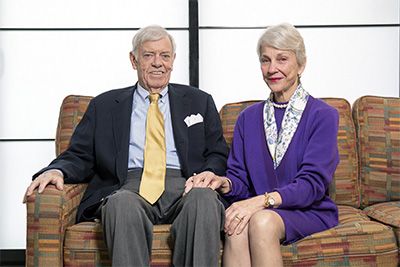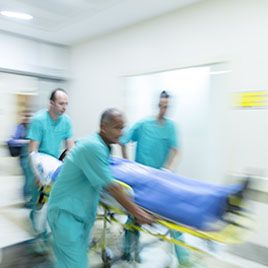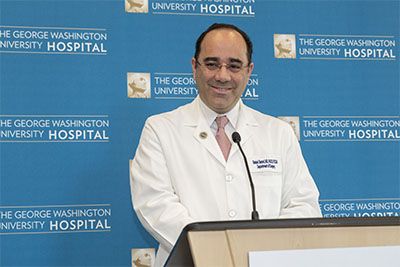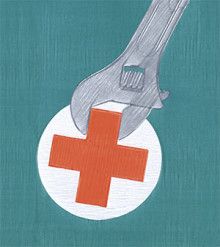Blinding lights. The touch of his sister’s hand stroking his hair. The deep sound of his father’s voice. That’s what Dewayne Brown remembers upon waking up at the George Washington University (GW) Hospital after being shot in the heart while washing his car on Oct. 20, 2017.
The team at GW Hospital running its Level I trauma center was able to quickly operate on Brown, repairing his heart and saving his life.
Brown remembers the care of the nurses and doctors, the passion with which they did their jobs. “It made me happy. Because when something like that happens, you don’t have control over things. You’re so used to doing what you need to do for yourself, and then that control is lost,” Brown says in a shaking voice.
As a third-generation Washingtonian, Brown says he has witnessed gun violence all his life. “I’ve seen it, and it’s so devastating.”
The United States is engaged in a heated debate over gun violence, and that includes the role medical professionals should play in the epidemic. But Babak Sarani, MD ’97, RESD ’04, director of trauma and acute care surgery at the GW Medical Faculty Associates (GW MFA), co-medical director of critical care at the GW Hospital, and professor of surgery and of emergency medicine at the GW School of Medicine and Health Sciences (SMHS), says with conviction what medical professionals can do: hold discourse on injury prevention, present facts about the effects of gun violence, and improve collaboration in communities on gun violence prevention.
GW is already conducting ample work in those areas — through a new trauma lecture series, gun violence research, tactical emergency casualty care training, and student education — and more is on the horizon.

The realities of gun violence came crashing in for Rosemary Bowes, PhD, assistant clinical professor of psychiatry and behavioral sciences at SMHS, when she and her husband, David Bigelow Bowes, a retired journalist, lost their grandnephew, Vaughn Bigelow Jr., at the hands of a gunman. The 13-year-old was with his mother and two brothers in the parking lot of their dentist’s office when the gunman opened fire following a road rage incident. Vaughn Jr. was killed, while his mother and one of his brothers suffered critical injuries.
“What happened with Vaughn Jr., his mother, and his siblings was, you know … ,” says Bowes, her voice trailing off. “It’s your family. How did that happen? It’s heartbreaking, and it makes me so angry. But I said ‘We’ve got to try to do something about this.’ ”
Bowes had long wanted to give back to GW through a lecture series, she says. The question was, what should the series address? Vaughn Jr.’s death led to the answer: the Rosemary and David Bowes Lecture Series on Trauma and Critical Care.
It was decided the series, endowed in perpetuity by Bowes, would provide support for an annual discussion on gun-related violence. Sarani says his vision for the lectures is all-encompassing, covering topics including the history of medicine in gun violence treatment and research and education on gun violence interventions.
Although the series will always be held at GW, Sarani says he wants it to be more than a GW event. “I envision this including everyone. All the D.C. area trauma centers, maybe people from the city government, the police department, fire department.”
Bowes adds that she wants the series to be like a creek that leads into a river, action that ripples outward. Her vision includes videos, a website, and other educational materials on gun violence. “We can’t prevent all gun violence, but we can have a voice in the care of those impacted by it,” she says. “We have to do even more to take care of all affected people. How do we do that?”

She asserts that there needs to be greater education and innovation when it comes to the “chain of custody of a patient” and the patient’s journey from where the trauma occurs, to the ER, to the recovery room, to physical therapy, and beyond.
“Vaughn Jr.’s mother and brother would not have survived if the people in the dentist’s office had not come out and started CPR,” she says. “They wouldn’t have survived the wait for the EMTs. And then the EMTs came and did their job and got them to the OR so they could get into surgery and then into recovery. This kind of coordination is so important, and we need to be working to improve it, and to create a new normal from chaos.”
The first lecture in the series, held on May 8, brought many out to hear from C. William Schwab, MD, founding chief of Penn Medicine’s Trauma Center. Schwab spoke about the formation of the trauma center and its growth into a robust enterprise dedicated to caring for the injured as well as to its research into mitigating the risk of injury from all trauma, but particularly gunshot wounds. During the lecture he also told the personal story of his early days as a trauma surgeon and the impact his profession has had on him.
Taking a Tactical Approach
The lecture series is the newest way GW is addressing gun violence, but other stakeholders also are working hard in this area, including Geoff Shapiro, director of emergency medical services and tactical/operational medicine at SMHS.
While supporting the military special operations community, Shapiro and colleagues saw the positive impact of Tactical Combat Casualty Care (TCCC), a threat-based medical training program that was created with the help of Kevin O’Connor, DO, associate professor of medicine at SMHS and director of executive medicine at the GW MFA. TCCC helps train military members to save lives on the battlefield from injuries that previously would have been fatal. “These people survived and had excellent outcomes,” Shapiro says. “We realized we needed to start teaching this to civilians.”
TCCC, which uses military language and is geared toward military populations, needed to be translated for the civilian space. That led Shapiro, E. Reed Smith, MD, associate clinical professor of emergency medicine at SMHS, and others to create a new national program called Tactical Emergency Casualty Care (TECC). The first meeting about the program occurred in 2013, and the effort has ballooned from there, even gaining support from the Federal Emergency Management Agency through a $1.3 million grant.
TECC, says Shapiro, is now accepted as the standard for high-threat medicine in the civilian world, including for mass shooting events. The program is meant for police officers, firefighters/EMS personnel, and other first responders.
Some of what TECC training provides is a different kind of first aid, Shapiro says. “EMTs learn to control bleeding, but historically we haven’t done as well as we could to teach people to be aggressive. We don’t teach people to move victims out of harm’s way when possible,” he explains.
The program also teaches first responders how to provide psychological support. “We address how they can talk to their patients, to comfort them. Imagine being injured and thinking you might die and no one’s talking to you. So even with EMS providers, we recommend they look the person in the eye and say ‘I know you’re here, I see you, I’ll come back for you,’ ” Shapiro says.
TECC also includes a program for bystanders called “Be the Help.” It features training as simple as hypothermia prevention, with tips that include moving someone from a tile floor to carpet, which will keep the person warmer.
As public awareness of mass shootings grows, Shapiro says there’s an increase in interest in programs like TECC. “What used to be a harder sell, especially because we’re asking people in law enforcement and fire/EMS to change behaviors, is now becoming the norm,” he says. “And bystanders, they’re more empowered now because of awareness. We need to start moving that ball forward. It’s still new, but I think we’ll see it continue to grow.”
In addition to training and education, medical professionals play a role in helping patients who may be at risk for violence, says O’Connor.
“When you hear about gun violence, the important thing to remember is that it’s two words: ‘gun’ and ‘violence,’ ” he says. “A small percentage of medical professionals will pursue the important work of balancing Second Amendment freedoms with imperatives for public safety. But every one of us is in a position to address the other word, ‘violence.’ We all can remember that social determinants of health overlap with social determinants of violence. We are in positions to immediately impact these factors; we can identify and address depression, signs of abuse, or domestic stressors. We need to make those critical interventions — and we can make them today.”
He adds that every day clinicians can help people who may be at risk for domestic violence, criminal violence, or self-harm. “It’s there; you can see it,” he says. “We need to help our learners develop the skill set and moral courage to address it.”

battlefield emergency care experiences to the civilian setting.
Advocating for a Safer Future
Future doctors, physician assistants, and physical therapists in training also are realizing the importance of enhanced education when it comes to helping patients affected by gun violence.
SMHS students formed a GW chapter of SAFE, or Scrubs Addressing the Firearm Epidemic, a coalition of doctors, nurses, medical students, and health care providers committed to protecting patients’ health.
Kime McClintock and Charles Hartley, Class of 2020 MD students and members of the SMHS Social Justice Interest Group, wanted to focus on timely and important causes. SAFE is addressing gun violence in a nonpartisan way, through research, education, and evidence-based policy, says Hartley.
“We want to take something that can be divisive, but touches all of us, and put aside political disagreements and look at the ways that have been proven for how this issue can be handled,” Hartley says.
The GW SAFE chapter has held informational sessions on gun violence and hosted guest lecturer Kyle Fischer, MD, clinical assistant professor at the University of Maryland School of Medicine, who spoke about what interventions medical professionals can initiate to help victims of gun violence.
Students also can participate in the Disaster Medicine Scholarly Concentration, the only such program in the United States, says James Phillips, MD, who serves as co-director of the concentration with Joelle Simpson, MD, emergency medicine specialist at Children’s National Health System.
Phillips is the chief of the Disaster and Operational Medicine Section within the Department of Emergency Medicine and is also the director of the disaster medicine fellowship. Phillips says disaster medicine is a subspecialty of experts trained to care for injuries and illnesses associated with both natural and human disasters, and who provide education, consultation, and leadership at all levels of government and private industry. They are trained to respond to domestic and international mass-casualty incidents, perform research, and help shape policy.
The “disaster cycle,” a model for the disaster medicine and emergency management approach, is a continuum of preparedness, mitigation, incident, response, and recovery, says Phillips. “We prefer to focus the budget and training more ‘left of boom,’ which is preparedness and mitigation, instead of ‘right of boom,’ which is response and recovery. History has repeatedly shown us that preparation and mitigating against the effects of a disaster before it happens is significantly cheaper than responding and recovering from one.”
He adds that there’s been a heavier focus on mass shooting incidents in recent years because lethality is high and targets tend to be “soft,” meaning they are low-security places such as night clubs and schools. “It’s something we can train people to survive,” adds Phillips, “there’s an emphasis on that.”
It has now been more than a year and a half since Dewayne Brown’s life was turned upside down by gun violence. The memory and trauma of that October day are still raw; the scar on his chest still gives him pain and his recovery has been challenging, but he is facing and overcoming obstacles each day. He’s back to walking in his favorite spot, Haines Point, and has returned to working out at the YMCA whenever he can.
“I’m just trying to live a real good life,” he says, softly, “a real peaceful life.”
Trauma Care 24/7
Twenty-four hours a day, seven days a week the George Washington University (GW) Hospital’s Center for Trauma and Critical Care is poised to meet the needs of any trauma patient who comes through its doors.
Just six blocks from the White House, three from the State Department, and down the street from the World Bank, GW Hospital has to be prepared at all times to treat a diverse group of patients, from area residents to visiting dignitaries and heads of state.

The center is certified as a Level I Trauma Center by the Verification Review Committee of the American College of Surgeons, the highest achievement possible in adult trauma care.
The levels assigned to trauma centers are defined by the type of capabilities facilities must have to care for patients. Level I means a facility has the capacity in terms of both equipment and personnel to treat any injured patient who presents to the hospital regardless of the severity of the patient’s injury. The GW trauma center treats more than 2,000 patients each year and is staffed at all times by a team of trauma surgeons, emergency medicine physicians, trauma-trained nurses, anesthesiologists, intensivists, operating room personnel, therapists, and other medical professionals.
“The trauma center is ready to fire up an operating room with less than 15 minute’s notice,” says Babak Sarani, MD ’97, RESD ’04, director of trauma and acute care surgery at the GW Medical Faculty Associates, co-medical director of critical care at the GW Hospital, and professor of surgery and of emergency medicine at the GW School of Medicine and Health Sciences.
“That means the team spends the night here. The nurses spend the night here, the technicians spend the night here, the anesthesiologists spend the night here, everyone who needs to be here is here.”
‘Don’t Be a Bystander’
Conventional wisdom for responding to someone who is hurt has always been “don’t touch them, don’t move them.” But that long-held advice no longer applies when it comes to massive bleeding.
“For major bleeding, the most important thing is to keep the blood inside the body. The leading cause of death on the battlefield is bleeding. So address that immediately,” says Kevin O’Connor, DO, director of executive medicine at the George Washington University (GW) Medical Faculty Associates and associate professor of medicine at the GW School of Medicine and Health Sciences.
O’Connor knows what he’s talking about. He spent 22 years as a physician in the United States Army, many of those years deployed with Special Operations Forces, before serving for more than a decade in the White House. In 2009, he was appointed as physician to the vice president, providing care for then Vice President Joe Biden and his family.
When it comes to managing bleeding, O’Connor says, the four Ds are key: detecting the source of the bleeding; direct pressure on the source of the bleed; devices, such as tourniquets, hemostatic dressings, and pressure bandages, to stem bleeding; and don’t dilute, or avoiding use of IV fluids that may raise blood pressure and dilute critical clotting factors, thus interfering with the very things the body is doing to stem the bleeding.
He adds that “the name of the game is to perfuse the squash” — meaning responders should make sure the victim is getting enough oxygen to the brain.

“Pretty much everything from the nose down is ultimately there to deliver oxygen and glucose to the brain. The brain is very demanding and if it doesn’t get oxygen and glucose every several seconds, it will shut down and die,” he says. “Anything you do that takes away from that delivery hurts. So how much is too much pressure? You need enough blood pressure to keep the brain happy – but not so much that it pushes more blood out of those holes until they are definitively plugged. The most fundamental action to diagnose shock, or inadequate perfusion, is ‘I think, therefore I am.’ So if you’re talking to me, you’re good.”
He also says to feel for a peripheral pulse — one felt in the extremities. The presence of a peripheral pulse and mentation are the best field indicators of adequate perfusion.
An easy way to triage in a crowd, as long as the scene is safe, is to shout “anyone who is injured, come to the sound of my voice,” O’Connor adds. Then have anyone capable of assisting go to check on the people who did not step forward, because the patients on the ground are a lot sicker, and need the most help, he explains.
The reason, he adds, that gunshot wounds cause such destructive injuries is that the energy found in the bullet speed is transferred to the tissue.
“Kinetic energy is half of the mass multiplied by the velocity squared. If you have a heavier object, you’re going to deliver more kinetic energy. But increasing the velocity of that object is going to increase the kinetic energy exponentially as compared to simply increasing the mass, which is why a bullet does a lot more damage than a knife,” he says.
When a bullet leaves the muzzle of a firearm, he continues, it will lose some of that energy when traveling through the air, but once impact occurs, the bullet will flatten. That causes a cavity that will crush and tear as the bullet moves through. This is known as the permanent cavity.
But more important, he says, is what comes next: the shockwave behind the bullet. That forms a temporary cavity, and that nearly instantaneous violent stretch is where the massive damage happens. “The shockwave can expand up to 30 times bigger than the permanent cavity. So find the entrance wound, try to determine the direction of the tract, imagine that hole 30 times bigger, and anything in that range is damaged until you can prove it isn’t,” he says.
For bystanders, the most important thing to do is stop the bleeding however possible.
“You’re not going to make them worse,” he says. “You can only help keep the blood inside the body. Refuse to be a bystander. Be a by-doer! By-doers are our nation’s ‘immediate responders.’ ”



